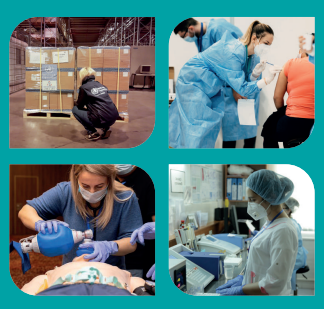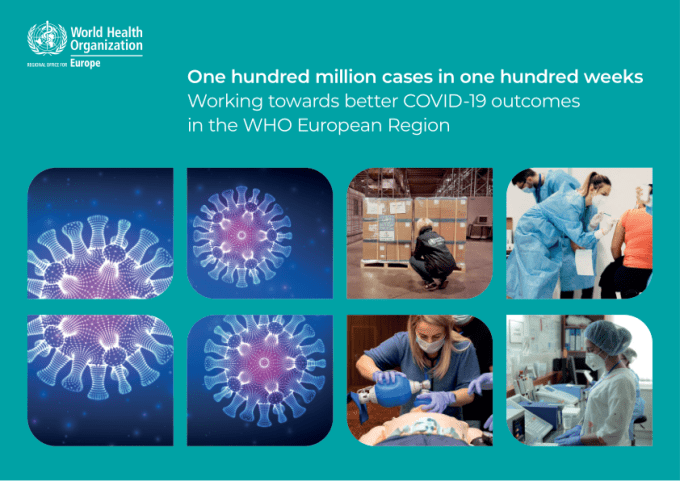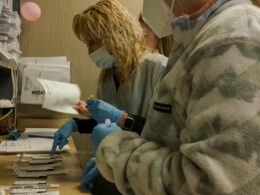One hundred million cases in one hundred week: Working towards better COVID-19 outcomes in the WHO European Region — World
Reliefweb int
12 Mar 2022
Two years of COVID-19 pandemic: new report highlights the 100 weeks of WHO/Europe’s efforts to protect lives and livelihoods
11 March 2022 is a grim milestone as we mark 2 years since WHO categorized the COVID-19 outbreak as a pandemic — a health emergency spanning countries and continents.
Since cases of COVID-19 were first reported, more than 6 million people have died from the disease worldwide, with over 1.8 million of them in the WHO European Region.
The new WHO/Europe report titled “One hundred weeks of emergency response, one hundred million COVID-19 cases: working towards better COVID-19 outcomes in the WHO European Region” showcases the achievements of WHO/Europe’s COVID-19 Incident Management Support Team (IMST) — the mechanism activated to deal with emergency situations — from its establishment in early 2020, as the first cases of COVID-19 were being detected in the European Region, to 2022. It also includes insights into the work of the operational teams during this time as they supported some of the Region’s Member States in dealing with the challenges of a global pandemic.
Quoted in the report is Dr Dorit Nitzan, former Regional Emergency Director for WHO/Europe, who said, “The COVID-19 Incident Support Management Team has been the engine of WHO/Europe’s response to COVID-19 by generating knowledge and operationalizing it in countries with governments and partners”.
Working to meet country needs
The report details the IMST’s work and the impact of its COVID-19 responses across various functions, including surveillance, public health and social measures, risk communication and community engagement, clinical and health interventions, essential health services, vaccines and operations, showing how each of these pillars contributed to meeting the needs of countries in three key areas:
- strategic, by providing continuously updated guidelines and technical recommendations, combined with capacity building activities such as webinars and trainings;
- technical, by providing global and regional expertise, channeling financial resources and delivering essential supplies to where they are most needed; and
- operational, by providing continuous country-specific support through on-the-ground deployments and missions staffed by technical experts, and through technical assistance delivered remotely.
Commenting on the report’s launch, Dr Gerald Rockenschaub, recently appointed Regional Emergency Director for WHO/Europe, said, “This new report underlines how the IMST’s expertise and flexibility over the last two years have been crucial for providing Member States with the most timely and appropriate support for dealing with a complex and ever-evolving situation. Through solidarity, perseverance and patience, we can defeat this virus together”.
Originally published at https://reliefweb.int on March 12, 2022.
Names mentioned
Dr Gerald Rockenschaub, recently appointed Regional Emergency Director for WHO/Europe

Situation overview
From the first COVID-19 cases in Europe reported on 24 January 2020, the pandemic reached 1 million cases within 3 months, 10 million cases within 8 months, and 100 million cases in Europe alone within 2 years.
Over the course of its two years, COVID-19 has claimed over 1.6 million lives across Europe and Central Asia.
The World Health Organization (WHO) European Region has accounted for close to a third of the cumulative global COVID-19 cases and deaths.
The pandemic has had, and continues to have, a profound impact on health, disproportionately affecting older age groups across the European Region.
In early 2020, people 50 years and older accounted for about 70% of cases and close to 100% of deaths.
Over the course of the pandemic, as testing expanded, vaccination rolled out, and transmission dynamics changed, these demographics shifted.
By the end of 2021, nearly 70% of those infected were between the ages of 5 and 49 years, while those over 50 continued to account for the majority of reported deaths.
The epidemiological trends in the Region were heavily impacted by the successive emergence of severe acute coronavirus-2 (SARS-CoV-2) variants of concern (VOCs), leading to waves of transmission spreading across the entire Region, accelerated by the regional calendar of events, holidays, and celebrations.
By April 2021, the more transmissible Alpha VOC had become dominant in the European Region, detected in 90.1% of sequenced samples. As cases started to stabilize in the Region, a new variant, Delta VOC, spread rapidly across the Region, replacing Alpha as the dominant virus by August 2021.
With higher transmissibility and limited immune escape, the resurgence linked to the spread of Delta led to increased infections across the European Region, and increased mortality where vaccination uptake was low, with regional cases reaching peak levels in the third quarter of 2021.
The Omicron VOC, first detected in Europe at the end of November 2021, presents clear evidence of the continued and significant evolution of SARS-CoV-2, with obvious implications for the Region and the world with its widespread transmission anywhere in the world.
Following the rapid roll-out of vaccines, many high income countries, particularly in the western part of the Region, began seeing signs of stabilization marked by reduced mortality and hospitalization rates.
Uptake across the Region increased rapidly and, as of November 2021, over 53% of the total population had received a complete vaccination series.
A study1 (2) published in November 2021, by the WHO Regional Office for Europe and European Centre for Disease Prevention and Control (ECDC) estimates that 470 000 lives have been saved among those aged 60 years and over since the start of COVID-19 vaccination roll-out in 33 countries across the WHO European Region.
However, from September 2021, the European Region saw a significant resurgence of cases as it approached the winter season.
The start of 2022 will bring new challenges as countries face this most recent wave of transmission, coupled with the fight against vaccine hesitancy and the new circulating Omicron variant.
In the context of the pandemic, a combination of vaccination and strong public health measures offer the clearest path to getting transmission under control.
The trajectory of COVID-19 in the coming weeks, months, and year will be largely determined by the decisions and actions taken by individuals, communities and governments.
With the support of Member States and partners at the global, regional, national, and community levels, WHO/Europe continues to work to reduce transmission across the European Region.

Delivering the COVID-19 response in the European Region
WHO’s Emergency Response Framework (ERF), adopted in 2017, sets out WHO’s Incident Management System (IMS) as a standardized structure and approach adopted to manage responses to public health events and emergencies. The use of six regional incident management support teams (IMSTs) drove WHO’s implementation of the COVID-19 Strategic Preparedness and Response Plan (SPRP). (3, 4)
Since its activation on the morning of 23 January 2020, the WHO Regional Office for Europe’s (WHO/Europe) COVID-19 IMST has provided an agile, adaptive framework to respond to the specific COVID-19 preparedness and response needs of a highly diverse Region (A timeline of WHO’s response to COVID-19 in the WHO European Region: a living document) (1). A tailored strategy and concept of operations was developed for the Region to prevent the spread of the pandemic, save lives, and minimize adverse impacts on populations, guiding the response and WHO’s actions to support countries.
The WHO Regional Office for Europe’s response is built around the comprehensive global SPRP to end the acute phase of the pandemic and build resilience and readiness for the future by establishing four main goals:
(i) prepare and be ready,
(ii) detect, protect and treat,
(iii) reduce transmission, and
(iv) innovate and learn.
The WHO/Europe response framework has relied on a dual track of continued health system functionality and emergency response operations in a cycle of
(i) defining interventions for countries,
(ii) delivering support through country operations, and
(iii) collecting/analysing regional epidemiology, surveillance and other health information.
It also looks towards phasing in new learning and opportunities for capacity-strengthening into resilient health systems that address everyone and leave no one behind. As such, the WHO/ Europe response included, from the very beginning, health systems experts and functions

The IMST was designed and organized to meet a range of country needs and built in the following features to the WHO/Europe concept of operations for COVID-19:

- Strategic, providing continuously updated guidelines and technical recommendations, combined with capacity-building activities such as webinars and training sessions.
- Technical, providing global and regional expertise, channelling financial resources and delivering essential supplies to where they are needed most.
- Operational, providing continuous country-specific support through on-the-ground deployments and missions staffed by technical experts, and through technical assistance delivered remotely.
To best serve its Member States, WHO’s response has been adapted to the diverse contexts across the European Region, where countries implement a wide range of national and subnational responses.
his has required a flexible and adaptable approach to national and subnational contexts, which is helping to prepare countries for a phased transition from widespread transmission to a steady state of low-level or no transmission.
This approach also accommodates the need to look to the future and incorporate new lessons and opportunities to strengthen capacity and build resilient health systems that will leave no one behind.
Countries at the centre, with subregional hubs steering the response
Countries witnessing widespread transmission of COVID-19 rapidly saw public health systems, particularly intensive hospital care, pushed to their limits. WHO/Europe’s immediate strategy for countries was:
(i) to slow and stop transmission, prevent outbreaks where possible and delay spread where not;
(ii) to provide optimized care for all patients, especially the seriously ill; and
(iii) to minimize the impact of the epidemic on health systems, social services and economic activity.
WHO/Europe configured its response to COVID-19 using the scenario of many countries of the Region entering a state of community transmission. The focus quickly moved towards sustained response with continued and broad engagement required across European and Central Asian countries. WHO/Europe’s IMST extends well beyond the WHO Regional Office for Europe.
The existing hub-and-spoke structure in place for the WHO Health Emergencies Programme (WHE) in the Region has been heavily utilized in the context of COVID-19. WHO/Europe’s country offices maintain IMSTs. The IMSTs engage directly with United Nations country teams (UNCTs) and take a whole-of-government approach to reinforce and strengthen the role of national and subnational health authorities.
During the COVID-19 pandemic, the hub-and spoke structure prioritized 17 countries and territories in the Region based on the following characteristics: health systems in transition, ongoing conflict, political challenges or political instability. As part of the COVID-19 IMST, three WHE Hubs (Balkans, South Caucasus and Central Asia) have served as technical and operational extensions of the Regional Office in Copenhagen, positioned directly to accelerate operational support to priority countries.
Partner coordination The COVID-19 response of WHO/Europe’s COVID-19 IMST has relied heavily on fostering existing and new strategic partnerships with hundreds of international, regional, national, and local partners to promote multisectoral responses in the Region. Such partners include the European Centre for Disease Prevention and Control (ECDC), which is a critical partner for WHO both within and beyond the European Union/European Economic Area (EU/EEA). In May 2020, WHO/Europe established a joint task force with the Central European Initiative (CEI) to step up regional coordination regarding the COVID-19 response. This task force has enabled experts in various health fields to work together to equip Member States with robust mechanisms to tackle common challenges and strengthen their COVID-19 response, with tangible results for the entire Region. Additionally, WHO/Europe has convened high-level meetings with representatives of the ministries of health of countries of the Commonwealth of Independent States (CIS), health-care experts and representatives of other United Nations (UN) agencies, such as the Joint United Nations Programme for HIV/AIDS (UNAIDS), issuing joint memorandums that address new pandemic challenges and other health-care issues in the CIS.
Other new and existing platforms were established and strengthened to coordinate the response, such as the Regional Working Group on COVID-19 vaccination, UN–Red Cross Movement and WHO coordination platform, and the joint WHO–ECDC networks for laboratory and COVID-19 surveillance in the Region. Partnering with local communities has also been a strategic element of WHO’s response. In April 2021, for example, WHO launched an initiative to empower civil society organizations (CSOs), as these have made a critical impact in reducing the effects of COVID-19 on individuals and communities, particularly the most vulnerable.
These critical strategic partnerships have been developed and cultivated in parallel with the operational partnerships that have enabled WHO/ Europe to translate these strategies to lifesaving outcomes in the field. Operational partners have continued to play a critical role, especially in the first six months of 2020. These include emergency medical teams (EMTs), the Global Outbreak Alert and Response Network (GOARN), rapid response mobile laboratories, public health institutes, and academic institutions such as the London School of Hygiene and Tropical Medicine, among others.
Though long recognized by WHO, the responses to this pandemic have only reinforced the notion that no single country or organization alone can protect people’s health in times of emergency. An effective response depends on collaboration among the work of many partners dedicated to improving the health and well-being of populations affected by crises. Leaving no one behind and building back better remain the ultimate goals of WHO’s work in the European Region.
Public communication and analysis
In addition to the operational nature of the IMST’s COVID-19 response, WHO/Europe has ensured continuous communication and transparency with the public, ranging from media updates (i.e. interviews with news outlets), statements by the Regional Director, technical briefings, and beyond. Feeding into this delivery of important information is analysis of the latest science to increase the understanding of the disease. Such analysis efforts include assessment missions, behavioural insights work, and more.












